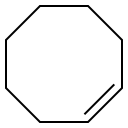BIS(CYCLOOCTENE)IRIDIUM(I) CHLORIDE, DIMER
Synonym(s):[Ir(coe)2Cl]2;Di-μ-chlorotetrakis(cyclooctene)diiridium
- CAS NO.:12246-51-4
- Empirical Formula: C32H56Cl2Ir28*
- Molecular Weight: 896.13
- MDL number: MFCD00213465
- SAFETY DATA SHEET (SDS)
- Update Date: 2024-04-28 19:50:54

What is BIS(CYCLOOCTENE)IRIDIUM(I) CHLORIDE, DIMER?
Chemical properties
Yellow solid
The Uses of BIS(CYCLOOCTENE)IRIDIUM(I) CHLORIDE, DIMER
Chlorobis(cyclooctene)iridium(I) dime is used as catalyst for Isomerization-hydroboration reactions with nido-carboranyldiphosphine as stabilizing ligand, Hydrogen peroxide oxidation of hydroxamic acids and their subsequent hetero Diels-Alder cycloaddition reactions, Immobilization of organic functional groups onto solid supports through vinylsilane coupling reactions, Alkylation reactions, Guerbet reaction, Allylic amination reactions in a DNA-diene-iridium(I) hybrid system, Asymmetric hydroamination reactions.
What are the applications of Application
Chlorobis(cyclooctene)iridium(I)dimer is a catalyst for many reactions, including alkylation reactions and Guerbet reactions
Properties of BIS(CYCLOOCTENE)IRIDIUM(I) CHLORIDE, DIMER
| Melting point: | 160-165 °C (dec.) (lit.) |
| storage temp. | under inert gas (nitrogen or Argon) at 2-8°C |
| solubility | Soluble in organic solvents. |
| form | crystal |
| color | yellow |
| Sensitive | moisture sensitive, store cold |
Safety information for BIS(CYCLOOCTENE)IRIDIUM(I) CHLORIDE, DIMER
| Signal word | Warning |
| Pictogram(s) |
 Exclamation Mark Irritant GHS07 |
| GHS Hazard Statements |
H315:Skin corrosion/irritation H319:Serious eye damage/eye irritation H335:Specific target organ toxicity, single exposure;Respiratory tract irritation |
| Precautionary Statement Codes |
P261:Avoid breathing dust/fume/gas/mist/vapours/spray. P264:Wash hands thoroughly after handling. P264:Wash skin thouroughly after handling. P271:Use only outdoors or in a well-ventilated area. P280:Wear protective gloves/protective clothing/eye protection/face protection. P302+P352:IF ON SKIN: wash with plenty of soap and water. P305+P351+P338:IF IN EYES: Rinse cautiously with water for several minutes. Remove contact lenses, if present and easy to do. Continuerinsing. |
Computed Descriptors for BIS(CYCLOOCTENE)IRIDIUM(I) CHLORIDE, DIMER
BIS(CYCLOOCTENE)IRIDIUM(I) CHLORIDE, DIMER manufacturer
Omkar Lab
1Y
Phone:91-9326135973
Whatsapp: +91-9326135973
product: 12246-51-4 Chlorobis(cyclooctene)iridium(I)dimer 98%
Johnson Matthey Chemicals India Pvt Ltd
1Y
Phone:+91-9711869003
Whatsapp: +91-9711869003
product: 12246-51-4 98%
Omkar Lab
Maharashtra
Phone:91-9326135973
Whatsapp: 91-9326135973
product: Chlorobis(cyclooctene)iridium(I)dimer
New Products
Tert-butyl bis(2-chloroethyl)carbamate (S)-3-Aminobutanenitrile hydrochloride N-Boc-D-alaninol N-BOC-D/L-ALANINOL N-octanoyl benzotriazole 3,4-Dibenzyloxybenzaldehyde 4-Hydrazinobenzoic acid 1,1’-CARBONYLDIIMIDAZOLE R-2-BENZYLOXY PROPIONIC ACID 4-HYDROXY BENZYL ALCOHOL 1,1’-CARBONYLDI (1,2-4 TRIAZOLE) 3-NITRO-2-METHYL ANILINE (2-Hydroxyphenyl)acetonitrile 4-Bromopyrazole 5-BROMO-2CYANO PYRIDINE 5,6-Dimethoxyindanone 5-broMo-2-chloro-N-cyclopentylpyriMidin-4-aMine 2-(Cyanocyclohexyl)acetic acid 4-methoxy-3,5-dinitropyridine 2-aminopropyl benzoate hydrochloride 1-(4-(aminomethyl)benzyl)urea hydrochloride tert-butyl 4- (ureidomethyl)benzylcarbamate diethyl 2-(2-((tertbutoxycarbonyl)amino) ethyl)malonate Ethyl-2-chloro((4-methoxyphenyl)hydrazono)acetateRelated products of tetrahydrofuran
You may like
-
 12246-51-4 Chlorobis(cyclooctene)iridium(I)dimer 98%View Details
12246-51-4 Chlorobis(cyclooctene)iridium(I)dimer 98%View Details
12246-51-4 -
 12246-51-4 98%View Details
12246-51-4 98%View Details
12246-51-4 -
 Chlorobis (cyclooctene)iridium (I) Dimer CAS 12246-51-4View Details
Chlorobis (cyclooctene)iridium (I) Dimer CAS 12246-51-4View Details
12246-51-4 -
 Chlorobis(cyclooctene)iridium(I) Dimer CAS 12246-51-4View Details
Chlorobis(cyclooctene)iridium(I) Dimer CAS 12246-51-4View Details
12246-51-4 -
 Chlorobis(cyclooctene)iridium(I)dimer CAS 12246-51-4View Details
Chlorobis(cyclooctene)iridium(I)dimer CAS 12246-51-4View Details
12246-51-4 -
 N-Vinylformamide 99%View Details
N-Vinylformamide 99%View Details
13162-05-5 -
 2-ethyl-6-methyl-3-hydroxypyridine succinate 99%View Details
2-ethyl-6-methyl-3-hydroxypyridine succinate 99%View Details
127464-43-1 -
 2-ETHYLPYRIDINE 100-71-0 99%View Details
2-ETHYLPYRIDINE 100-71-0 99%View Details
100-71-0
Statement: All products displayed on this website are only used for non medical purposes such as industrial applications or scientific research, and cannot be used for clinical diagnosis or treatment of humans or animals. They are not medicinal or edible.

